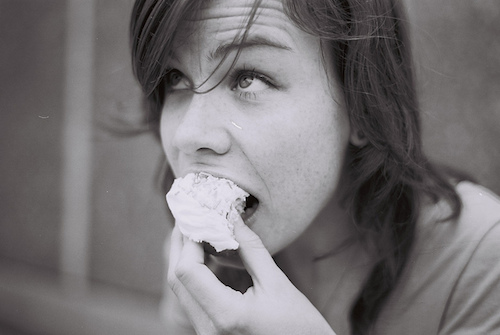I was sure I had already done everything I could. I didn’t eat candy or processed foods and if I did have a baked good, it was a muffin that either I had made myself or bought from the health food store.
I cleaned up my diet over decades, living for many years as a vegetarian and then a vegan.
I had gone organic in my early twenties, and for awhile, I even industriously made my own bread. I was committed to health through food and lifestyle and had made a good deal of progress but still had digestive problems.
Gluten-free, dairy-free, vegan…there was precious little left to remove from my regime. Out of desperation, I decided to monitor my sugar intake.
I came to this decision after downloading a popular fitness app onto my phone. After entering the day’s food, it spit out a tally which clearly showed I had eaten too much sugar—way too much. I was shocked. I was under the impression that since my diet was made up primarily of organic whole foods then I would surely be within the realm (probably well below) of the recommended sugar intake for a woman my size—24 grams.
This was a complete delusion.
It was startling when I entered my breakfast banana into the food tracker and saw that this one item had 19 grams of sugar—nearly my daily allotment. I might eat two bananas, a couple servings of other fruits as well as a fruit/nut/seed bar in the afternoon. The alternative coffee creamer I had been using had one gram of sugar in every tablespoon and the pasta sauce—a whopping six grams in a half cup.
This all added up to nearly 100 grams of sugar in my average day.
I paused here and sat with this new information. It was difficult to reconcile the fact that I was consuming about four times as much sugar as the government, always on the lookout for its citizens’ good health, recommends. I’m more of the alternative health kind of person and this struck me hard as, in my opinion, the mainstream guidelines generally underestimate the requirements for optimal health.
Truthfully, I didn’t want to admit that I had a problem with sugar addiction, but I started thinking about my taste preferences and family history. Coming from a long line of alcoholics, I was familiar with the intense craving for sweets the typical alcoholic will experience after coming off alcohol.
I’m not a drinker, but I do remember seeking comfort from a bag of M&Ms with my mother and my sister in my childhood kitchen while drunks and chaos roamed freely throughout the rest of the house.
The more I mulled this over in my head, the more I felt panic. I reminded myself of an alcoholic in an intervention shouting, “I don’t have a problem!” I had allowed myself to be in avoidance, and then interestingly, while resting in this stage, I started gathering information about sugar and the effects of overconsumption. Looking back, my behavior followed exactly the same progression as that of a child when faced with a new and unappealing chore- resistance, resignation and then interest.
The more I learned, the more pieces began to fall into place—pieces that I hadn’t even been aware existed. My mom died at the young age of 60 from Alzheimer’s Disease and a seizure disorder. I learned that there is a strong connection between Alzheimer’s and type 3 diabetes. Even moderately increased blood sugar levels may contribute to Alzheimer’s and cognitive degeneration.
I also learned about the role inflammation plays in the ailments of body and mind, including many mental illnesses such as depression and anxiety.
Sugar sends inflammation soaring.
I began cutting sugar and processed carbohydrates (even whole grain flour is technically a processed food) from my diet immediately. I presented this new information to my family along with ways for them to make better decisions. For instance, my pre-adolescent athletic son investigated his “recovery drink” and found nearly 40 grams of sugar in the bottle, and it was purchased from the health food store.
Stopping consumption of these was a great place for him to start. He continues to make better choices, and he completely eliminated ketchup (four grams/tablespoon), puts two (instead of just one) hot dogs into his gluten-free bun, and eats a bit of fermented kim chi every morning with breakfast to cut sugar cravings
My children, all elite athletes, enjoy reading about others in the sports world who have left sugar behind. It’s an impressive lineup: Steve Nash, Phil Mickelson (PGA Golfer), Kobe Bryant, Novak Djokovic (top ranked professional tennis player), Carol Nichols (USA Field Hockey), and Amanda Beard Brown (seven time Olympic Medalist—Swimming).
Cutting sugar has opened up a new world for me and my family. Our dental checkups have gone from less than stellar to perfectly wonderful. Our complexions have cleared—teenage acne, ruddiness, puffy undereye bags appear now only if we’ve indulged for more than a day or so.
Overall, our digestive consistency, energy and capacity to enjoy life has increased immensely.
On a day-to-day basis, this fuels our desire to continue with this way of eating in hopes of living long, healthy lives both physically and mentally.
Listen to your body—it will tell you when you have it right.
–
Relephant:
Important Reasons to Avoid Sugar.
Sugar is 8 times as Addictive as Cocaine—How to Break the Cycle.
Author: Terese Keehan
Apprentice Editor: Lisa Foreman / Editor: Renee Picard
Image: Thomas Abbs/Flickr







Read 3 comments and reply